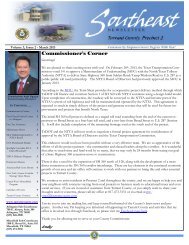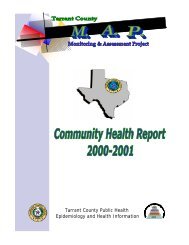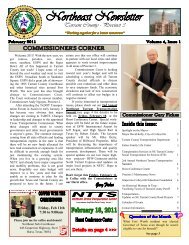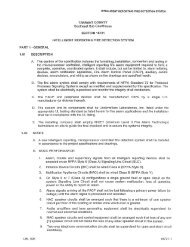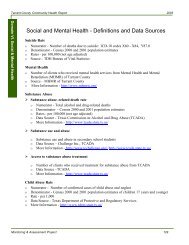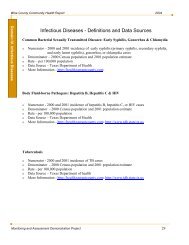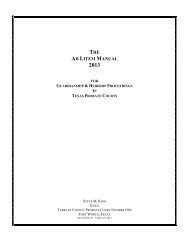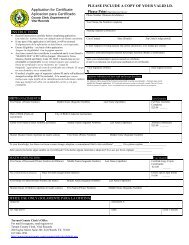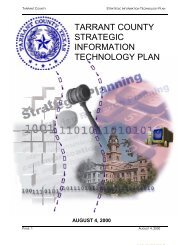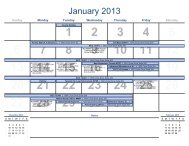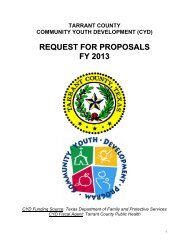Forensic Death Investigation - Tarrant County
Forensic Death Investigation - Tarrant County
Forensic Death Investigation - Tarrant County
You also want an ePaper? Increase the reach of your titles
YUMPU automatically turns print PDFs into web optimized ePapers that Google loves.
TARRANT ARRANT COUNTY OUNTY MEDICAL EDICAL EXAMINER XAMINER’S DISTRICT ISTRICT<br />
SERVING ERVING TARRANT ARRANT, , DENTON DENTON,<br />
, JOHNSON JOHNSON<br />
& PARKER PARKER<br />
COUNTIES OUNTIES<br />
2011 ANNUAL ANNUAL<br />
REPORT EPORT
TARRANT COUNTY MEDICAL EXAMINER’S DISTRICT<br />
CURRENT ACCREDITATIONS<br />
NATIONAL ASSOCIATION OF MEDICAL EXAMINERS (N.A.M.E.)<br />
2010 - 2015<br />
AMERICAN SOCIETY OF CRIME LABORATORY DIRECTORS/<br />
LAB ACCREDITATION BOARD (ASCLD/LAB)<br />
2009 - 2014<br />
AMERICAN COLLEGE OF GRADUATE MEDICAL EDUCATION (ACGME)<br />
2011 - 2015<br />
TARRANT COUNTY MEDICAL EXAMINER<br />
AND FORENSIC SCIENCE LABORATORIES<br />
200 FELIKS GWOZDZ PLACE, FORT WORTH, TEXAS 76104<br />
OFFICE: 817-920-5700 FAX: 817-920-5713<br />
www.tarrantcounty.com/emedicalexaminer
FROM THE OFFICE OF THE TARRANT COUNTY CHIEF MEDICAL EXAMINER<br />
Our Commitment and Philosophy . . .<br />
Whenever we are called upon to assist, even if it is outside the defined<br />
jurisdiction, out of the scope of our duties, or otherwise removed from our<br />
responsibilities under the law, it is our general policy to help the individual<br />
reach the appropriate person, agency or organization who can assist.<br />
Our Mission Statement . . .<br />
The primary purpose of the <strong>Tarrant</strong> <strong>County</strong> Medical Examiner’s Office is to<br />
assist the public and law enforcement agencies to determine the cause of<br />
death due to unnatural causes, medically unattended or death due to<br />
violence, using state of the art laboratory and forensic science facilities.<br />
Sincerely,<br />
Dr. Nizam Peerwani<br />
Chief Medical Examiner
2<br />
TABLE OF CONTENTS<br />
Our Commitment and Philosophy 1<br />
Preface 3<br />
Brief History of Medical Examiner Office 4<br />
2011 Summary 5<br />
Staff Photos 6-7<br />
Organization Chart 8<br />
TCME District Staff 9<br />
Biographies 12<br />
General Statistical Summary 17<br />
<strong>Death</strong> <strong>Investigation</strong> Statistics 18<br />
Five Year Comparison 19<br />
Accidents, Homicides and Suicides by Method 20<br />
TCME Section Descriptions<br />
� <strong>Forensic</strong> <strong>Death</strong> <strong>Investigation</strong> 21<br />
� Human Identification Laboratory 22<br />
� The Morgue and Evidence 23<br />
� <strong>Forensic</strong> Chemistry and Toxicology Laboratory 24<br />
� Chemistry & Breath Alcohol Testing Statistics 25<br />
� Toxicology Statistics 26<br />
� Criminalistics Laboratories 27<br />
� Histology / Secretarial / Business Office/ Building Superintendent 29<br />
Child Fatality Review Team 30<br />
Education 31<br />
New Construction 32
PREFACE<br />
The <strong>Tarrant</strong> <strong>County</strong> Medical Examiner’s Office was originally established in<br />
1965 to serve <strong>Tarrant</strong> <strong>County</strong> alone but today it also serves Denton, Johnson<br />
and Parker counties with a total district population exceeding 2.8 million. This<br />
area is experiencing a dramatic growth, and the <strong>Tarrant</strong> <strong>County</strong> Medical<br />
Examiner’s Office is committed to continue providing the highest quality of<br />
service to the loved ones of the deceased and to the legal system.<br />
Understanding the need to have knowledge in ever-growing subjects of<br />
anatomy, physiology, chemistry, and biology, and applying this knowledge to<br />
the science of determination of the cause of death has become a routine<br />
requirement for the staff at the <strong>Tarrant</strong> <strong>County</strong> Medical Examiner’s Office. A<br />
combination of staff with outstanding qualifications, sophisticated state-of-the-art<br />
equipment, strict compliance with statutes and regulations and accreditation by<br />
the National Association of Medical Examiners and the American Society of<br />
Crime Laboratory Directors Laboratory Accreditation Board make the <strong>Tarrant</strong><br />
<strong>County</strong> Medical Examiner’s Office one of the premier medical examiner offices<br />
in the nation. In addition to a staff of five highly trained, board certified forensic<br />
pathologists, the office boasts a 24 hour investigative staff and a full<br />
complement of support services, including Human Identification, Toxicology,<br />
Criminalistics, and <strong>Forensic</strong> Photography laboratories.<br />
The wealth of information available at the office, coupled with an interest to<br />
share and educate, prompts the staff to provide educational opportunities such<br />
as the Tuesday morning forensic rounds, the annual “Current Trends In<br />
<strong>Forensic</strong> Science” conference, a twelve month forensic pathology fellowship,<br />
monthly autopsy classes, periodic training sessions with Physicians for Human<br />
Rights and training at the International <strong>Forensic</strong> Science Center to provide<br />
advanced forensic training to scholars from abroad. Members of the staff are<br />
often invited to provide services, give lectures, and provide consultation<br />
nationally and internationally.<br />
As you review this report, we hope we have imparted an appreciation for the<br />
depth of our commitment to excellent quality and service. Every day presents<br />
new challenges which this Office strives to meet. We are always seeking to<br />
develop and implement new services and procedures to better serve you and<br />
the community.<br />
3
4<br />
A BRIEF HISTORY OF THE MEDICAL EXAMINER’S OFFICE<br />
1965 <strong>Tarrant</strong> <strong>County</strong> Commissioners Court establishes the <strong>Tarrant</strong> <strong>County</strong> Medical Examiner’s<br />
Office. T.C. Terrell, M.D. is named Chief Medical Examiner.<br />
1969 Feliks Gwozdz, M.D. is named Chief Medical Examiner<br />
1979 After Dr. Gwozdz’s unexpected death, Nizam Peerwani, M.D. is appointed Chief Medical<br />
Examiner<br />
1980 First <strong>County</strong>-wide central morgue is established on the campus of Texas College of<br />
Osteopathic Medicine (Now University of North Texas Health Science Center)<br />
1982 Toxicology and histology laboratories are added; shortly after, forensic dentistry is added to<br />
the office in order to assist in human identification<br />
1986 Parker <strong>County</strong> officially joins the Medical Examiner’s Office, creating the <strong>Tarrant</strong> <strong>County</strong><br />
Medical Examiner’s District<br />
1989 Denton <strong>County</strong> joins the Medical Examiner’s District<br />
The <strong>Tarrant</strong> <strong>County</strong> Medical Examiner’s District moves into a new state of the art facility at<br />
200 Feliks Gwozdz Place, renamed in honor of Dr. Gwozdz. In addition to modern up to<br />
date toxicology and histology laboratories, the new facility also includes a full service crime<br />
laboratory offering forensic biology, trace analysis, latent fingerprint and firearm/tool mark<br />
examinations.<br />
1993 The <strong>Tarrant</strong> <strong>County</strong> Medical Examiner’s District provides the death scene investigation and<br />
medical examiner services for McLennan <strong>County</strong> in the aftermath of the Branch Davidian<br />
incident at Mt. Carmel, Texas.<br />
2003 The position of <strong>Forensic</strong> Anthropologist, formerly a part-time position within the office,<br />
becomes a full-time position, making the <strong>Tarrant</strong> <strong>County</strong> Medical Examiner’s District the<br />
only Medical Examiner’s Office in Texas with a full-time forensic anthropologist.<br />
2007 The Human Identity Section is established, consisting of the <strong>Forensic</strong> Odontologist,<br />
<strong>Forensic</strong> Anthropologist and one Latent Fingerprint Examiner.<br />
2008 Johnson <strong>County</strong> joins the Medical Examiner’s District.<br />
2011 Construction completed on new building expansion.
2011 Summary<br />
New Hires:<br />
January 4th - Charles Clow joined the staff as a Senior Firearm/Toolmark Examiner.<br />
March 16th - Michael Pollard joined the <strong>Tarrant</strong> <strong>County</strong> Staff as a <strong>Forensic</strong> <strong>Death</strong><br />
Investigator. He previously served as the Chief FDI in the Johnson <strong>County</strong><br />
office.<br />
April 4th - Robert Johnson, Ph.D. joined the staff as Chief Toxicologist.<br />
July 1st - Jerry Mendlowski, M.D. joined the staff to begin his one year <strong>Forensic</strong> Pathology<br />
fellowship.<br />
October 26th - Brian Lane joined the staff as a part-time Histotechnician. This position is<br />
grant funded.<br />
November 22nd - Tarr Jae Wilson joined the staff as the Records Secretary.<br />
December 4th - Susan Roe, M.D. joined the staff as a Deputy Medical Examiner.<br />
New Building: In September 2011 construction was completed on the building and the<br />
Toxicology, Chemistry, Crime Labs and Evidence Departments took occupancy of their new<br />
spaces. The moves went smoothly and the labs experienced minimal down time. The project was<br />
completed on time, within budget, and more than doubled our existing space.<br />
The building was designed and constructed with the goal of achieving a certain LEED status.<br />
LEED Certification stands for Leadership in Energy and Environmental Design and is the<br />
nationally accepted benchmark for the design, construction, and operation of high performance<br />
green buildings. Certification assures that a building project is environmentally responsible,<br />
profitable, and a healthy place to work. We anticipate being awarded LEED Gold Certification.<br />
5
TARRANT COUNTY MEDICAL EXAMINER’S OFFICE<br />
AND FORENSIC LABORATORIES<br />
8<br />
Nizam Peerwani<br />
Chief Medical Examiner<br />
Marc Krouse, M.D.<br />
Deputy Chief ME<br />
Michael Smith<br />
Histologist<br />
Jerry Mendlowski, M.D.<br />
<strong>Forensic</strong> Fellow<br />
Susan Roe, M.D.<br />
Deputy ME<br />
Gary Sisler, D.O.<br />
Deputy ME<br />
Lloyd White, M.D.<br />
Deputy ME<br />
Ronald Singer<br />
Administrative Director<br />
Tracye Poirier<br />
Business Manager<br />
Marsy Key<br />
Bookkeeper<br />
Roger Metcalf<br />
Chief Human ID<br />
Michael Mayer<br />
<strong>Forensic</strong> Biologist<br />
Susan R. Howe<br />
Crime Lab Supervisor<br />
Robert Johnson<br />
Chief Toxicologist<br />
Traci Wilson<br />
Dir. Morgue/Evidence<br />
Michael Floyd<br />
Chief <strong>Forensic</strong><br />
<strong>Death</strong> Investigator<br />
Linda Anderson<br />
Executive Assistant<br />
Dana Austin<br />
Sr. Anthropologist<br />
John Briggs<br />
Supervisor<br />
Constance Patton<br />
Sr. <strong>Forensic</strong> Biologist<br />
Sabra Botch<br />
Sr. Toxicologist<br />
Joyce Ho<br />
Lab Manager<br />
Ronnie Redic<br />
Sr. Autopsy Tech<br />
Cathy Adolph<br />
Medical Secretary/<br />
Transcriptionist<br />
Biology/DNA<br />
William Bailey<br />
Latent Print Examiner<br />
Jennifer Valentine<br />
Sr. <strong>Forensic</strong> Biologist<br />
Robert Corley<br />
FDI I<br />
Gloria Hamilton<br />
FDI II<br />
Beryl Landry<br />
Toxicologist<br />
Rufus “Glynn” Dill<br />
Autopsy Tech/Evidence<br />
Denton Co.<br />
4 F/T; 1 P/T Inv.<br />
Human<br />
Toxicology<br />
Andrea Corder<br />
Medical Secretary/<br />
Transcriptionist<br />
Patricia Elrashid<br />
Autopsy Tech/Evidence<br />
James Greenwell<br />
FDI I<br />
Jimmy McDonald<br />
FDI II<br />
AFIS<br />
Carolyn Van Winkle<br />
Sr. <strong>Forensic</strong> Biologist<br />
Connie Lewis<br />
Toxicologist<br />
Johnson Co.<br />
2 F/T; 2 P/T Inv.<br />
Deatra Keele<br />
Medical Secretary/<br />
Transcriptionist-Lab<br />
Esther Gutierrez<br />
Autopsy Tech/Evidence<br />
Michael Pollard<br />
FDI I<br />
Stephen White<br />
FDI II<br />
Kelly Belcher<br />
Sr. Trace Analyst<br />
Cheryl Wheeler<br />
Sr. Toxicologist<br />
Parker Co.<br />
1 F/T; 3 P/T Inv.<br />
Trace Analysis<br />
Patricia Eddings<br />
Sr. Trace Analyst<br />
Burshauna Hill<br />
Autopsy Tech/Evidence<br />
Amy Renfro<br />
FDI I<br />
Carol Lawson<br />
Medical Secretary/<br />
Transcriptionist<br />
Christina Coucke-Garza<br />
Sr. <strong>Forensic</strong> Chemist<br />
Christie Smith<br />
Vital Statistics Secretary<br />
Alberto Medina<br />
Autopsy Tech/Safety<br />
Larry Steffler<br />
FDI I<br />
William Walker<br />
Latent Print Examiner<br />
Fingerprints<br />
John Harris<br />
Sr. <strong>Forensic</strong> Chemist<br />
Drug Chemistry<br />
Tarr Jae Wilson<br />
Records Secretary<br />
Michelle O’Neal<br />
Sr. <strong>Forensic</strong> Chemist<br />
Katrina Ortiz<br />
Autopsy Tech/Evidence<br />
Paul Krieg<br />
Investigative Clerk<br />
Jamie Becker<br />
Sr. Firearms Examiner<br />
Novella Young<br />
Records Manager<br />
Firearms/<br />
Toolmarks<br />
Sarah Skiles<br />
Sr. <strong>Forensic</strong> Chemist<br />
Brittany Dodson<br />
Investigative Clerk<br />
Charles Clow<br />
Sr. Firearms Examiner<br />
William Fondren<br />
Sr. <strong>Forensic</strong> Chemist<br />
Breath Alcohol<br />
Lavena Hernandez<br />
Investigative Clerk<br />
Larry Reynolds<br />
<strong>Forensic</strong> Photographer<br />
Photography<br />
Tracy Vancil<br />
Investigative Clerk
<strong>Tarrant</strong> <strong>County</strong> Medical Examiner’s District Staff<br />
Medical Examiners<br />
Nizam Peerwani, M.D. Chief Medical Examiner<br />
Marc Krouse, M.D. Deputy Chief Medical Examiner<br />
Susan J. Roe, M.D.. Deputy Medical Examiner<br />
Gary Sisler, D.O. Deputy Medical Examiner<br />
Robert Lloyd White, M.D. Ph.D. Deputy Medical Examiner<br />
Jerry Mendlowski, M.D. <strong>Forensic</strong> Fellow<br />
Administration<br />
Ronald L. Singer, M.S. Technical Administrative Director<br />
Business Office<br />
Tracye Poirier, M.B.A. Business Manager<br />
Marsy Key Bookkeeper<br />
<strong>Forensic</strong> <strong>Death</strong> <strong>Investigation</strong><br />
<strong>Tarrant</strong> <strong>County</strong><br />
Mike Floyd, B.S. Chief <strong>Forensic</strong> <strong>Death</strong> Investigator<br />
John Briggs Supervisory Investigator<br />
Gloria Hamilton, B.S. <strong>Forensic</strong> <strong>Death</strong> Investigator II<br />
Jimmy McDonald <strong>Forensic</strong> <strong>Death</strong> Investigator II<br />
Stephen White <strong>Forensic</strong> <strong>Death</strong> Investigator II<br />
Robert Corley <strong>Forensic</strong> <strong>Death</strong> Investigator I<br />
James Greenwell <strong>Forensic</strong> <strong>Death</strong> Investigator I<br />
Michael Pollard . <strong>Forensic</strong> <strong>Death</strong> Investigator I<br />
Amy Renfro, B.S <strong>Forensic</strong> <strong>Death</strong> Investigator I<br />
Larry Steffler <strong>Forensic</strong> <strong>Death</strong> Investigator I<br />
Brittany Dodson Investigative Clerk<br />
Lavena Hernandez, M.S. Investigative Clerk<br />
Paul Krieg Investigative Clerk<br />
Tracy Vancil, B.S. Investigative Clerk<br />
Denton <strong>County</strong><br />
Troy Taylor, B.S. Chief <strong>Forensic</strong> <strong>Death</strong> Investigator<br />
Bill Mills, Jr., B.S. <strong>Forensic</strong> <strong>Death</strong> Investigator<br />
Robert Murphy <strong>Forensic</strong> <strong>Death</strong> Investigator<br />
Julie Carriker <strong>Forensic</strong> <strong>Death</strong> Investigator<br />
Terry Martin <strong>Forensic</strong> <strong>Death</strong> Investigator<br />
Janan Kline Secretary<br />
9
10<br />
Johnson <strong>County</strong><br />
Gary Morris Chief <strong>Forensic</strong> <strong>Death</strong> Investigator<br />
Liesl Hoover Secretary/<strong>Forensic</strong> <strong>Death</strong> Investigator<br />
Jamie Smith <strong>Forensic</strong> <strong>Death</strong> Investigator<br />
Cassie Clewis <strong>Forensic</strong> <strong>Death</strong> Investigator<br />
Parker <strong>County</strong><br />
Regina Banks, Chief <strong>Forensic</strong> <strong>Death</strong> Investigator<br />
Jim Nichols <strong>Forensic</strong> <strong>Death</strong> Investigator<br />
Lavena Hernandez, M.S. <strong>Forensic</strong> <strong>Death</strong> Investigator<br />
Heather Casey <strong>Forensic</strong> <strong>Death</strong> Investigator<br />
<strong>Forensic</strong> Chemistry and Toxicology Laboratory<br />
Robert Johnson, Ph.D. Chief Toxicologist<br />
Joyce Ho, B.S. Toxicology Lab Manager<br />
Sabra Botch, M.S. Senior <strong>Forensic</strong> Toxicologist<br />
Cheryl Wheeler, B.S. Senior <strong>Forensic</strong> Toxicologist<br />
Beryl Landry, B.S. <strong>Forensic</strong> Toxicologist<br />
Connie Lewis, B.S. <strong>Forensic</strong> Toxicologist<br />
Christina Coucke-Garza, M.S. Senior <strong>Forensic</strong> Chemist<br />
Mark Fondren, M.S. Senior <strong>Forensic</strong> Chemist<br />
John Harris, M.S. Senior <strong>Forensic</strong> Chemist<br />
Michelle O’Neal, B.S. Senior <strong>Forensic</strong> Chemist<br />
Sarah Skiles, B.S. Senior <strong>Forensic</strong> Chemist<br />
Criminalistics Laboratory<br />
Susan Howe, D.V.M., Ph.D. Crime Lab Supervisor<br />
Michael Mayer, B.S. <strong>Forensic</strong> Biologist<br />
Constance Patton, B.S. Senior <strong>Forensic</strong> Biologist<br />
Jennifer Valentine, M.S. Senior <strong>Forensic</strong> Biologist<br />
Carolyn Van Winkle, M.S. Senior <strong>Forensic</strong> Biologist<br />
Kelly Belcher, M.S. Senior Trace Analyst<br />
Patricia Eddings, B.S. Senior Trace Analyst<br />
William Walker Latent Fingerprint/AFIS Specialist<br />
Jamie Becker, B.S. Sr. Criminalist-Firearms and Tool Marks<br />
Larry Reynolds <strong>Forensic</strong> Photographer<br />
Histology<br />
Mike Smith, B.S. <strong>Forensic</strong> Histotechnician<br />
Leticia Hidalgo, B.S. Part-time <strong>Forensic</strong> Histotechnician<br />
Brian Lane Part-time <strong>Forensic</strong> Histotechnician
Human Identification Laboratory<br />
Roger Metcalf, D.D.S. Chief of Identification Services<br />
Dana Austin, Ph.D. Senior <strong>Forensic</strong> Anthropologist<br />
William Bailey Latent Fingerprint/AFIS Specialist<br />
Morgue/Evidence Services<br />
Traci Wilson Director of Morgue/Evidence Services<br />
Ronnie Redic Senior Autopsy Technician<br />
Glynn Dill Autopsy Tech/Evidence<br />
Patricia Elrashid Autopsy Tech/Evidence<br />
Esther Gutierrez Autopsy Tech/Evidence<br />
Burshauna Hill Autopsy Tech/Evidence<br />
Alberto Medina Autopsy Tech/Evidence<br />
Katrina Ortiz Autopsy Tech/Evidence<br />
Secretarial Services<br />
Linda Anderson Executive Assistant/PIO<br />
Cathy Adolph Medical Secretary/Transcriptionist<br />
Andrea Corder Medical Secretary/Transcriptionist<br />
Deatra Keele Medical Secretary/Transcriptionist-Lab<br />
Carol Lawson Medical Secretary/Transcriptionist<br />
Novella Young Records Manager<br />
Tarr Jae Wilson Records Secretary<br />
Christie Smith Vital Statistics Secretary<br />
Building Superintendent<br />
Jun Lumadilla<br />
11
12<br />
MEDICAL EXAMINER STAFF<br />
NIZAM PEERWANI, M.D. - CHIEF MEDICAL EXAMINER<br />
Dr. Peerwani is a graduate of the American University of Beirut (M.D. in<br />
1976). He completed his residency in pathology at Baylor University<br />
Medical Center in Dallas, and is board certified in anatomic, clinical and<br />
forensic pathology. Currently he is the Chief Medical Examiner for<br />
<strong>Tarrant</strong>, Denton, Johnson and Parker counties in the state of Texas and<br />
has held this position since July 1979. He is an advocate of child safety<br />
and served on the Texas Child Fatality Review Committee as an expert in<br />
<strong>Forensic</strong> Medicine. Dr. Peerwani is also an advocate of Human Rights<br />
and serves as an expert consultant for Physicians for Human Rights with<br />
completed assignments in Rwanda, Bosnia, Indonesia, Cyprus,<br />
Afghanistan, Israel and Bahrain investigating genocide and human rights<br />
violations under the auspices of the United Nations Tribunal. Appointed by Governor Rick Perry in<br />
2009, Dr. Peerwani currently serves on the Texas <strong>Forensic</strong> Science Commission.<br />
MARC KROUSE, M.D. - DEPUTY CHIEF MEDICAL EXAMINER<br />
Dr. Krouse graduated from Texas A&M University with a B.S. degree<br />
(1974) in zoology, and from the University of Texas Southwestern<br />
Medical School with his M.D. (1977). He completed his pathology<br />
residency at Baylor University Medical Center and is board certified in<br />
anatomic, clinical and forensic pathology. Dr. Krouse began his career<br />
here as a Deputy Medical Examiner (1978 - 1985) and is currently serving<br />
as the Deputy Chief Medical Examiner (1985 - present). Dr. Krouse is a<br />
member of the National Association of Medical Examiners (NAME) and<br />
served two terms on their Board of Directors, as well as on various<br />
committees through the years. He is a member of the Association for<br />
the Advancement of Automotive Medicine, and also serves on the<br />
<strong>Tarrant</strong> <strong>County</strong> Disaster Response Program which assists in planning responses to acts of<br />
terrorism, as well as other natural disasters and accidents.<br />
GARY SISLER, D.O. - DEPUTY MEDICAL EXAMINER<br />
Dr. Sisler graduated from the University of Toledo with a B.S. degree<br />
(1959) before completing his D.O. degree (1965) at the Kansas City<br />
College of Osteopathic Medicine. A board certified diplomat of the<br />
American Board of <strong>Forensic</strong> Examiners and the American Board of<br />
<strong>Forensic</strong> Medicine, Dr. Sisler is also certified in anatomic and clinical<br />
pathology by the American Board of Pathology. After serving 29 years<br />
and achieving the rank of Colonel, United States Army Medical Corps,<br />
Dr. Sisler joined the medical examiner staff in 1989 as a Deputy Medical<br />
Examiner. In July of 2009 Dr. Sisler transitioned to part time status.
ROBERT LLOYD WHITE, M.D., PH.D. - DEPUTY MEDICAL EXAMINER<br />
Dr. White earned a B.S. degree (1965) from the University of Tulsa,<br />
Oklahoma and an M.D. (1972) as well as a Ph.D. degree (1976) from the<br />
University of Oklahoma. He completed his residency in anatomic and clinical<br />
pathology at Baylor University Medical Center in 1976, and completed a<br />
fellowship in forensic pathology through the Southwestern Institute of<br />
<strong>Forensic</strong> Sciences, University of Texas, and Southwestern Medical Center in<br />
Dallas. Dr. White’s medical specialty certification includes anatomic, clinical<br />
and forensic pathology. He worked with Affiliated Pathologists group in<br />
Denton, Texas between 1977 and 1989 as Director of Autopsy Services and also served as Chief of<br />
Medical Staff, Lewisville Memorial Hospital, Lewisville, Texas. Between 1989 and 1992 he served as<br />
Mississippi State Medical Examiner and visiting Clinical Assistant Professor of Pathology, University of<br />
Mississippi Medical Center. He worked as Nueces <strong>County</strong> Chief Medical Examiner, Corpus Christi,<br />
Texas between 1992 and 2002. He was a consulting forensic pathologist between 2002 and 2005. He<br />
joined the TCME staff in February 2005. In addition to his experience as a teacher and a researcher<br />
he also has a degree in Theology from the University of Dallas, Texas.<br />
SUSAN J. ROE, M.D. - DEPUTY MEDICAL EXAMINER<br />
Dr. Roe graduated from the University of Texas at Arlington with a B.S. in<br />
Nursing (1977) and from the University of Texas Health Science Center at<br />
Houston Medical School with an M.D. (1983). Post graduate training in<br />
anatomic pathology, clinical pathology and forensic pathology at Indiana<br />
University, Hennepin <strong>County</strong> Medical Center, and Hennepin <strong>County</strong><br />
Medical Examiner’s Office was completed in 1988. Dr. Roe is board<br />
certified in anatomic, clinical and forensic pathology. She worked as a<br />
<strong>Forensic</strong> Pathologist at the Hennepin <strong>County</strong> Medical Examiner’s Office,<br />
Ramsey <strong>County</strong> Medical Examiner’s Office and Minnesota Regional Medical<br />
Examiner’s Office from 1988 through 2011. In addition she was a Bush<br />
Foundation Medical Fellow, Class of 2003 and worked at the Jesse E.<br />
Edwards Registry of Cardiovascular Disease from 2005 through 2011. Dr. Roe joined the Medical<br />
Examiner staff in December 2011 as a Deputy Medical Examiner.<br />
JERRY MENDLOWSKI, M.D. - FORENSIC FELLOW<br />
Dr. Mendlowski graduated with a medical degree from the Jagiellonian<br />
Medical School in Cracow, Poland in 1982. He trained in pathology at the<br />
Health Science Center of the State University of New York in Syracuse. He is<br />
board certified in Anatomic and Clinical Pathology. He served as general<br />
pathologist at various community and rural hospitals throughout New York<br />
and Pennsylvania. Dr. Mendlowski joined the <strong>Tarrant</strong> <strong>County</strong> Medical<br />
Examiner’s Office on July 1, 2011 to begin his one year Fellowship training in<br />
<strong>Forensic</strong> Pathology. Upon successful completion of this year of training he<br />
plans to change his career focus to <strong>Forensic</strong> Pathology.<br />
13
14<br />
TRACYE POIRIER, M.B.A. - BUSINESS MANAGER<br />
Tracye Poirier received her B.S. degree in Chemistry from the University of Texas at<br />
Arlington. She came to work here in 2000 as a Senior <strong>Forensic</strong> Toxicologist. She also<br />
served as a Senior <strong>Forensic</strong> Chemist before assuming her current role as the<br />
Business Manager. Her background in the sciences provides her with unique insight<br />
into managing a Medical Examiner office. Ms. Poirier earned her M.B.A. degree with<br />
an emphasis in Strategic Leadership in April 2010 from the University of Dallas. Ms.<br />
Poirier is a member of the American Academy of <strong>Forensic</strong> Sciences and the<br />
Southwestern Association of Toxicologists.<br />
LINDA F. ANDERSON - EXECUTIVE ASSISTANT/PIO<br />
ADMINISTRATION<br />
RONALD SINGER, M.S. - TECHNICAL AND ADMINISTRATIVE DIRECTOR<br />
Ronald Singer received a B.S. degree from Tulane University and an M.S. degree<br />
from Loyola University of New Orleans. A forensic scientist since 1972, he has<br />
served as President of the International Association of <strong>Forensic</strong> Sciences, is a<br />
Distinguished Fellow and Past President of the American Academy of <strong>Forensic</strong><br />
Sciences, a Distinguished Member and Past President of the Association of Firearm<br />
and Toolmark Examiners, an Emeritus Member and Past Secretary of the American<br />
Society of Crime Laboratory Directors, and is a member of numerous other<br />
forensic associations and committees. He has been an invited speaker on forensic<br />
issues throughout the U.S., Hungary, Bosnia, England, Portugal, Turkey, the<br />
Maldives and Sri Lanka. Mr. Singer is a recipient of the American Academy of<br />
<strong>Forensic</strong> Sciences Criminalistics Section Outstanding Service Award, the<br />
Association of Firearm and Toolmark Examiners Member of the Year Award, the Gold Medal of the<br />
Mediterranean Academy of <strong>Forensic</strong> Sciences and the Distinguished Fellow Award from the American Academy<br />
of <strong>Forensic</strong> Sciences.<br />
SECRETARIAL SERVICES<br />
Accepting employment as a medical secretary in 1994, Ms. Anderson is currently the<br />
Executive Assistant for the Chief Medical Examiner and she supervises the clerical<br />
department. She is responsible for scheduling pathologists for morgue duty, directs<br />
scheduling of physicians for court appearances and professional engagements, trains<br />
secretarial staff, and interacts with families and the general public. In addition to<br />
these responsibilities she acts as the Public Information Officer for the office. Ms.<br />
Anderson’s previous employment history includes office manager/procurement<br />
technician for Harris Methodist Tissue Services and Court Clerk with the City of Fort<br />
Worth Municipal Court.<br />
MORGUE/EVIDENCE SERVICES<br />
TRACI WILSON - CHIEF OF MORGUE/LABORATORY SERVICES<br />
Traci Wilson began her employment with the <strong>Tarrant</strong> <strong>County</strong> Examiner’s Office as a<br />
<strong>Forensic</strong> Autopsy Technician in 1995. Prior to moving to Fort Worth she had worked<br />
as a <strong>Forensic</strong> Pathologist Assistant in Bossier City, LA. Ms. Wilson attended<br />
Northeast Louisiana University Monroe (ULM) where she majored in Business<br />
Administration/Business Law. In 2009 Ms. Wilson assumed the duties of Chief of<br />
Morgue/Laboratory Services, and has since worked hard to implement new policies<br />
to streamline record keeping and evidence handling.
HUMAN IDENTIFICATION SERVICES<br />
ROGER METCALF, D.D.S., J.D. – CHIEF OF HUMAN IDENTIFICATION SERVICES<br />
Roger Metcalf is a graduate of Baylor University and Baylor College of<br />
Dentistry. He completed a Fellowship in <strong>Forensic</strong> Odontology at the Center<br />
for Education and Research in <strong>Forensic</strong>s at the University of Texas Health<br />
Science Center at San Antonio Dental School under Dr. David Sinn. He<br />
received his J.D. degree from Texas Wesleyan University School of Law in<br />
2009. Dr. Metcalf has been a member of the <strong>Tarrant</strong> <strong>County</strong> Medical<br />
Examiner’s Mass Fatality Dental Identification Team since it was established<br />
in 1980, and participated in identification of victims from the Delta 191 and<br />
1141 crashes at DFW Airport, and from the Mt. Carmel Incident in Waco, TX. Since joining the <strong>Tarrant</strong><br />
<strong>County</strong> Medical Examiner’s District in 2004, Dr. Metcalf has supervised the forensic identification of<br />
more than 300 unidentified bodies per year. Dr. Metcalf is commissioned as a Lt. Colonel in the DFW<br />
Medical Ranger Group, Medical Reserve Corps, Texas Medical Brigade, Texas State Guard. He<br />
participates as an active member of the Wesleyan Innocence Project, a group that reviews possible<br />
exoneration cases for the Dallas <strong>County</strong> District Attorney’s Office.<br />
FORENSIC CHEMISTRY AND TOXICOLOGY LABORATORY<br />
ROBERT JOHNSON, PH.D. - CHIEF FORENSIC TOXICOLOGIST<br />
Dr. Johnson graduated from The University of Oklahoma with a Ph.D. in<br />
Analytical Chemistry in 2004. Certified as a forensic toxicologist by the<br />
American Board of <strong>Forensic</strong> Toxicology, he joined the medical examiner's<br />
office in 2011. Additionally, Dr. Johnson is active in several professional<br />
societies including the Society of <strong>Forensic</strong> Toxicologists, the American<br />
Academy of <strong>Forensic</strong> Sciences and the Southwestern Association of<br />
Toxicologists. He has published over 50 scientific articles in his career all of<br />
which deal specifically with forensic toxicology.<br />
CRIMINALISTICS LABORATORY<br />
SUSAN R. HOWE, D.V.M., PH.D. - CRIME LABORATORY DIRECTOR<br />
Dr. Howe received a B.S. and a Doctor of Veterinary Medicine degree from<br />
the University of Illinois, and a Ph.D. in Toxicology from Texas A & M<br />
University. A forensic scientist since 1996, she is an active member of the<br />
American Academy of <strong>Forensic</strong> Sciences, the International Association of<br />
<strong>Forensic</strong> Sciences, the Society of <strong>Forensic</strong> Toxicologists, and the<br />
Southwestern Association of Toxicologists. Dr. Howe is currently serving as<br />
President of the Southwestern Association of Toxicologists. Dr. Howe is<br />
board certified in <strong>Forensic</strong> Toxicology by the American Board of <strong>Forensic</strong><br />
Toxicology, and has published a number of scientific articles in peerreviewed<br />
journals in the field of molecular toxicology.<br />
15
16<br />
TARRANT COUNTY:<br />
PARKER COUNTY:<br />
FORENSIC DEATH INVESTIGATION<br />
MICHAEL FLOYD - CHIEF FORENSIC DEATH INVESTIGATOR<br />
Michael Floyd began working for the TCME District in 1990 as a Medical Investigator<br />
assigned to Parker <strong>County</strong> and he transferred to <strong>Tarrant</strong> <strong>County</strong> in 1993. In 1997 he<br />
was promoted to Senior <strong>Forensic</strong> Investigator, became the Supervisory Investigator<br />
in 2009, and was appointed the Chief <strong>Forensic</strong> Investigator in 2010. Prior to his<br />
employment at TCME Michael was a Texas-certified EMT-Paramedic for 16 years.<br />
Michael also holds a TCLEOSE Master Peace Officer certificate and Instructor<br />
license, and has been a commissioned peace officer since 1981. In 1984 he earned<br />
an Associate Degree from Weatherford College and in 1996 a B.S. degree from<br />
Texas Wesleyan University. Michael is a Diplomate of the American Board of<br />
Medicolegal <strong>Death</strong> Investigators.<br />
DENTON COUNTY:<br />
TROY TAYLOR, B.S. - CHIEF FORENSIC DEATH INVESTIGATOR<br />
Mr. Taylor started his career in 1990 at the Denton <strong>County</strong> Medical Examiner's<br />
Office. After multi-year tenures in Denton and <strong>Tarrant</strong> <strong>County</strong> he transferred back<br />
to the Denton office in 2003. Troy teaches medical examiner law, wound<br />
patterning, and decompositional changes for intermediate crime scene classes as<br />
well as basic peace officer certification classes. He has attended medico-legal death<br />
investigation training and psychological profiling schools. Mr. Taylor was promoted<br />
to Chief <strong>Forensic</strong> <strong>Death</strong> Investigator of Denton <strong>County</strong> in 2007.<br />
JOHNSON COUNTY:<br />
GARY MORRIS - CHIEF FORENSIC DEATH INVESTIGATOR<br />
Gary Morris began his service with the Johnson <strong>County</strong> Medical Examiner’s<br />
Office as a Reserve Investigator in 2006. Mr. Morris served in several<br />
positions, advancing to his current position as the Chief <strong>Forensic</strong> <strong>Death</strong><br />
Investigator for the Johnson <strong>County</strong> office, a position he has held since<br />
2011. He has attended <strong>Forensic</strong> <strong>Death</strong> <strong>Investigation</strong> training in Fort Worth,<br />
St. Louis, Arizona and New York.<br />
REGINA BANKS - CHIEF FORENSIC DEATH INVESTIGATOR<br />
Regina Banks has been Chief Investigator for Parker <strong>County</strong> since January<br />
2011. Prior to this appointment, she was an Investigator for the Denton<br />
<strong>County</strong> Medical Examiner's Office. Mrs. Banks graduated from the University<br />
of North Texas with a Bachelor of Arts degree in Psychology and a Bachelor<br />
of Science degree in Criminal Justice. Formerly Mrs. Banks worked as an<br />
Investigator for the State of Texas Department of Family and Protective<br />
Services.
TARRANT COUNTY MEDICAL EXAMINER’S DISTRICT<br />
Number<br />
Reported <strong>Death</strong>s: 8,708<br />
Jurisdiction Terminated: 6,294<br />
Jurisdiction accepted: 2,414<br />
Scenes investigated: 1,296<br />
Bodies brought to the facility: 2,414<br />
Medical Procedures: 2,414<br />
External: 1018 (42% of deaths certified)<br />
Partial Autopsies: 522 (22% of deaths certified)<br />
Complete Autopsies: 874 (36% of deaths certified)<br />
Manner of <strong>Death</strong>:<br />
<strong>Death</strong>s certified as Natural: 1,203 (50% of deaths certified)<br />
<strong>Death</strong>s certified as Accident: 668 (28% of deaths certified)<br />
(Non-motor vehicle: 420)<br />
(Motor vehicle: 248)<br />
<strong>Death</strong>s certified as Suicide: 293 (12% of deaths certified)<br />
<strong>Death</strong>s certified as Homicide: 153 (6% of deaths certified)<br />
<strong>Death</strong>s certified as Pending 1 (>1% of deaths certified)<br />
<strong>Death</strong>s certified as Undetermined: 73 (3% of deaths certified)<br />
<strong>Death</strong>s certified as Non-Human Remains: 23 (1% of deaths certified)<br />
Unidentified Bodies:<br />
GENERAL STATISTICAL SUMMARY<br />
2011<br />
Total Identified: 376<br />
Identified by fingerprints: 278<br />
Identified by anthropology: 28<br />
Identified by odontology: 27<br />
Identified visually: 22<br />
Identified by DNA: 13<br />
Identified by other means: 3<br />
Pending: 5<br />
17
18<br />
2011 DENTON COUNTY DEATHS<br />
MANNER OF DEATH CASES PERCENTAGE<br />
NATURAL 159 11%<br />
ACCIDENT 95 6%<br />
SUICIDE 66 4%<br />
HOMICIDE 11 1%<br />
PENDING 0 0<br />
UNDETERMINED 11 1%<br />
NON-HUMAN REMAINS 4 0<br />
JURISDICTION TERMINATED 1140 77%<br />
TOTAL 1486 100%<br />
2011 PARKER COUNTY DEATHS<br />
MANNER OF DEATH CASES PERCENTAGE<br />
NATURAL 72 16%<br />
ACCIDENT 29 7%<br />
SUICIDE 25 6%<br />
HOMICIDE 0 0<br />
PENDING 0 0<br />
UNDETERMINED 2 0<br />
NON-HUMAN REMAINS 3 1%<br />
JURISDICTION TERMINATED 312 70%<br />
TOTAL 443 100%<br />
2011 TARRANT COUNTY DEATHS<br />
MANNER OF DEATH CASES PERCENTAGE<br />
NATURAL 915 14%<br />
ACCIDENT 518 8%<br />
SUICIDE 190 3%<br />
HOMICIDE 138 2%<br />
PENDING 1 0<br />
UNDETERMINED 57 1%<br />
NON-HUMAN REMAINS 16 >1%<br />
JURISDICTION TERMINATED 4519 71%<br />
TOTAL 6354 100%<br />
2011 JOHNSON COUNTY DEATHS<br />
MANNER OF DEATH CASES PERCENTAGE<br />
NATURAL 57 13%<br />
ACCIDENT 26 6%<br />
SUICIDE 12 3%<br />
HOMICIDE 4 1%<br />
PENDING 0 0<br />
UNDETERMINED 3 1%<br />
NON-HUMAN REMAINS 0 0<br />
JURISDICTION TERMINATED 323 76%<br />
TOTAL 425 100%
FIVE YEAR COMPARISON<br />
TARRANT COUNTY<br />
Manner of <strong>Death</strong> 2011 2010 2009 2008 2007<br />
Natural 915 843 804 766 798<br />
Accidental 518 464 517 492 504<br />
Suicide 190 200 163 182 175<br />
Homicide 138 140 94 118 109<br />
Pending 1 0 1 0 14<br />
Undetermined 57 46 43 38 32<br />
Non-Human Remains 16 11 12 13 13<br />
Jurisdiction Terminated 4519 4541 4421 4406 5085<br />
Total 6354 6245 6055 6015 6730<br />
DENTON COUNTY<br />
Manner of <strong>Death</strong> 2011 2010 2009 2008 2007<br />
Natural 159 140 175 152 154<br />
Accidental 95 90 86 77 94<br />
Suicide 66 58 64 55 48<br />
Homicide 11 15 13 11 16<br />
Pending 0 0 0 0 0<br />
Undetermined 11 14 11 11 12<br />
Non-Human Remains 4 4 2 1 2<br />
Jurisdiction Terminated 1140 1079 989 1014 870<br />
Total 1486 1400 1339 1321 1196<br />
JOHNSON COUNTY<br />
(*Johnson <strong>County</strong> joined the TCME District on 7/1/2008)<br />
Manner of <strong>Death</strong> 2011 2010 2009 2008* 2007*<br />
Natural 57 60 45 26<br />
Accidental 26 29 24 26<br />
Suicide 12 29 16 10<br />
Homicide 4 1 0 1<br />
Pending 0 0 0 0<br />
Undetermined 3 1 4 0<br />
Non-Human Remains 0 2 1 0<br />
Jurisdiction Terminated 323 317 315 161<br />
Total 425 439 405 224<br />
PARKER COUNTY<br />
Manner of <strong>Death</strong> 2011 2010 2009 2008 2007<br />
Natural 72 50 42 50 55<br />
Accidental 29 32 38 37 35<br />
Suicide 25 18 10 11 17<br />
Homicide 0 1 2 4 4<br />
Pending 0 0 0 0 0<br />
Undetermined 2 1 2 2 0<br />
Non-Human Remains 3 0 2 4 0<br />
Jurisdiction Terminated 312 296 279 244 224<br />
Total 443 398 375 352 335<br />
19
20<br />
ACCIDENTS, HOMICIDES AND SUICIDES BY METHOD<br />
ACCIDENTS BY METHOD<br />
OTHER<br />
ASPHYXIATION 17 3% MOTOR VEHICLE<br />
DROWNING<br />
DRUGS<br />
ELECTROCUTION<br />
ENVIRONMENTAL<br />
40<br />
232<br />
6<br />
6<br />
6%<br />
34%<br />
1%<br />
1%<br />
FIRE<br />
FALL<br />
ENVIRONMENTAL<br />
FALL 100 15% ELECTROCUTION<br />
FIRE 6 1%<br />
DRUGS<br />
MOTOR VEHICLE 248 37%<br />
DROWNING<br />
OTHER 13 2% ASPHYXIATION<br />
HOMICIDES BY METHOD<br />
ASPHYXIATION 4 3%<br />
BLUNT FORCE TRAUMA 19 12%<br />
FIREARMS 88 57%<br />
MOTOR VEHICLE 24 16%<br />
SHARP FORCE 14 9%<br />
OTHER 4 3%<br />
SUICIDES BY METHOD<br />
ASPHYXIATION 13 4%<br />
DRUGS 28 10%<br />
FIREARMS 166 57%<br />
HANGING 69 23%<br />
JUMP 2 1%<br />
SHARP FORCE 5 2%<br />
OTHER 10 3%<br />
OTHER<br />
SHARP FORCE<br />
MOTOR VEHICLE<br />
FIREARMS<br />
BLUNT FORCE TRAUMA<br />
SHARP FORCE<br />
ASPHYXIATION<br />
ASPHYXIATION<br />
OTHER<br />
JUMP<br />
HANGING<br />
FIREARMS<br />
DRUGS<br />
6<br />
6<br />
6<br />
2<br />
13<br />
5<br />
17<br />
10<br />
13<br />
40<br />
28<br />
4<br />
4<br />
14<br />
19<br />
69<br />
100<br />
24<br />
166<br />
88<br />
232<br />
248
FORENSIC DEATH INVESTIGATION<br />
One of the primary purposes of the medical<br />
examiner’s office is to conduct inquests or<br />
investigations into the cause and manner of<br />
deaths occurring within <strong>Tarrant</strong>, Denton,<br />
Johnson and Parker Counties. The <strong>Tarrant</strong><br />
<strong>County</strong> Medical Examiner’s District staffs an<br />
around-the-clock investigative division<br />
responsible for initiating a formal response<br />
to all reportable cases.<br />
Investigators within the district made inquiries into<br />
more than 8700 deaths in 2011. <strong>Forensic</strong><br />
investigators are trained in a multi-disciplinary<br />
capacity and possess unique education and abilities,<br />
including knowledge of criminal investigation<br />
techniques, relevant aspects of forensic medicine,<br />
crime scene processing skills, and maintenance of<br />
case integrity. Additionally, each investigator must be<br />
capable of conducting effective interviews, locating<br />
and notifying next-of-kin, and interacting with law<br />
enforcement personnel.<br />
Once a jurisdictional death is reported, the<br />
investigator attends the scene or hospital where<br />
the death occurred. After conducting the initial<br />
investigation, the investigator prepares a detailed<br />
case report containing biographical data on the<br />
decedent, a narrative of the events leading up to<br />
the time of death or<br />
discovery of the<br />
decedent, and a<br />
summation of all<br />
i n v e s t i g a t i v e<br />
analyses and leads.<br />
I n a d d i t i o n ,<br />
i n v e s t i g a t o r s<br />
coordinate with<br />
h o s p i t a l s ,<br />
physicians, law enforcement agencies, employers,<br />
families, and other pertinent sources to gather<br />
information that might be of value to the determination<br />
of the cause and manner of death.<br />
21
22<br />
FORENSIC ODONTOLOGY<br />
HUMAN IDENTIFICATION LABORATORY<br />
Identification of unidentified remains is a primary function of the <strong>Tarrant</strong> <strong>County</strong> Medical<br />
Examiner’s Office. In order to more efficiently accomplish this task, the office has<br />
created the Human Identification Laboratory. Headed by a full time forensic<br />
odontologist, the laboratory staff also includes a full time forensic anthropologist, and<br />
utilizes the talents of the fingerprint examiners assigned to the crime laboratory.<br />
Unidentified remains are systematically examined using fingerprints, dental records,<br />
anthropological studies and DNA technology and making use of local, state and national<br />
data bases in an effort to provide identity and closure to the deceased and their families.<br />
Visual Fingerprints<br />
Dental Anthropology<br />
DNA<br />
<strong>Forensic</strong> dentists deal with a range of medicolegal<br />
problems. Identification of the human remains of<br />
natural disasters, terrorist activities, and missing and<br />
unknown persons is a central activity. The<br />
postmortem dental examination of human remains<br />
usually involves charting dental and cranial features,<br />
radiographic (x-ray) documentation of these features,<br />
and forensic report writing regarding these findings.<br />
Dental identification plays a particularly important<br />
role in the identification of victims of catastrophic<br />
events where there are massive numbers of<br />
casualties such as airplane crashes (Pan Am flight<br />
103 and American Airlines flight 587), fires, floods, earthquakes, or terrorist attacks<br />
(Oklahoma City Federal Building and the World Trade Center).<br />
FORENSIC ANTHROPOLOGY<br />
Bones comprise<br />
the structural<br />
framework of the<br />
human body. Due<br />
to their properties,<br />
bones decompose<br />
more slowly than<br />
many other tissues<br />
and organs; thus,<br />
they are often capable of providing clues that assist examiners in determining the cause<br />
and manner of death. Skeletal remains can provide information such as the race, stature,<br />
weight, age, and gender of the decedent. Evidence of trauma or natural disease may also<br />
be identified. X-ray comparisons can help establish scientifically the identity of a body.<br />
Samples of DNA can also be obtained from bone; thus, in cases where decomposition is<br />
advanced significantly, DNA analysis can still be of value. <strong>Tarrant</strong> <strong>County</strong> has the only<br />
comprehensive forensic anthropology laboratory attached to a medical examiner’s office in<br />
Texas.
THE MORGUE<br />
The main center of activity of any medical examiner’s<br />
facility is the morgue area. Dedicated in 1989, the<br />
<strong>Tarrant</strong> <strong>County</strong> Medical Examiner’s Office morgue<br />
area employs a design which centralizes all morgue<br />
activity, isolating it from the other activities of the<br />
building. There are two holding areas, each capable of<br />
holding fifty bodies. One of the areas is dedicated to<br />
incoming cases only, while the other holds bodies<br />
awaiting release. The main morgue consists of four<br />
workstations, each of which is designed to be<br />
conducive to a dynamic work environment in which examinations can be carried out<br />
with maximum efficiency. The morgue area also<br />
contains a separate major case morgue and a<br />
teaching morgue capable of seating 45 students.<br />
In addition a 2 station isolation/biohazard morgue<br />
was included in the new construction.<br />
Classroom instruction is an integral component of<br />
any medical education program. The <strong>Tarrant</strong><br />
<strong>County</strong> Medical Examiner’s Office regularly<br />
participates in the academic and practical training<br />
of students from the entire North Texas area by<br />
offering once a month autopsy classes.<br />
The morgue is staffed by autopsy technicians (deiners)<br />
who assist the pathologists with forensic examinations.<br />
Each autopsy technician is responsible for obtaining<br />
photographs, radiographs (X-rays), fingerprints, and<br />
biological samples from the<br />
decedent before autopsy.<br />
Because the identification of<br />
foreign bodies in or on a decedent is vitally important to a<br />
comprehensive examination, the medical examiner’s office<br />
relies on radiological techniques as a tool. Designed to<br />
facilitate easy access to radiographic equipment without<br />
moving the body from the transport gurney, the radiology<br />
lab incorporates a C-arm fluoroscope, a fixed flat plate<br />
device, and articulated dental radiography equipment.<br />
EVIDENCE HANDLING<br />
In order to preserve evidentiary integrity, each piece of evidence<br />
collected by or submitted to the medical examiner’s office for<br />
processing must be coupled with a detailed chain-of-custody<br />
log. To ensure the chain-of-custody is maintained correctly, and<br />
that all evidence is handled, cared for, and stored properly,<br />
forensic technicians with expertise in evidentiary preservation are utilized.<br />
23
24<br />
FORENSIC CHEMISTRY AND TOXICOLOGY LABORATORY<br />
FORENSIC CHEMISTRY<br />
<strong>Forensic</strong> chemists analyze drugs submitted by other<br />
agencies. Drug types<br />
received commonly range<br />
from clandestine chemical<br />
substances to therapeutic<br />
or prescribed medications.<br />
C o c a i n e , h e r o i n ,<br />
marijuana, and amphetamines, all drugs of abuse,<br />
represent the most common products received for<br />
chemical assay. Daily, law enforcement agencies within<br />
the medical examiner’s district are faced with the<br />
challenge of identifying drugs found subsequent to an<br />
arrest or search warrant execution.<br />
INTOXILYZER PROGRAM<br />
An intoxilyzer instrument provides an objective,<br />
scientific means of testing someone who is<br />
suspected by police to have been driving under the<br />
influence of alcohol by measuring a sample of the<br />
suspect’s breath for determinable levels of alcohol<br />
concentration. Grant funds supplied by the Texas<br />
Department of Transportation were used to establish<br />
the ME office’s intoxilyzer program in 1994. Under<br />
the program, forensic chemists establish intoxilyzer test sites, calibrate and<br />
maintain equipment, and train intoxilyzer operators, which benefits local police<br />
agencies.<br />
FORENSIC TOXICOLOGY<br />
<strong>Forensic</strong> toxicological services were established at the<br />
medical examiner’s office in 1983. Subsequently, the<br />
toxicology laboratory has expanded to include mass<br />
spectrometry, gas chromatography, and high-pressure<br />
liquid chromatography analysis. The toxicology laboratory<br />
provides drug testing to assist the<br />
medical examiners in determining the<br />
cause and manner of death by isolating,<br />
identifying, and determining the level of<br />
chemicals in specimens. Additionally,<br />
the forensic toxicology laboratory<br />
participates regularly in established<br />
analytical proficiency testing and quality assurance programs.
CHEMISTRY CASES RECEIVED<br />
2011<br />
CASES<br />
2010<br />
CASES<br />
2009<br />
CASES<br />
JAN 149 153 215<br />
FEB 171 115 198<br />
MAR 219 175 197<br />
APR 139 169 167<br />
MAY 118 183 192<br />
JUN 156 230 247<br />
JUL 254 178 224<br />
AUG 171 170 160<br />
SEP 181 177 183<br />
OCT 125 148 159<br />
NOV 210 181 120<br />
DEC 195 141 244<br />
TOTALS 2088 2020 2306<br />
BREATH ALCOHOL TESTING<br />
PROGRAM<br />
2011 2010 2009<br />
Breath Tests 2667 2828 3292<br />
Under 21 307 309 377<br />
Affidavits 800 868 861<br />
Testing Sites<br />
Supervised<br />
20 20 238<br />
Court Appearances<br />
(Days)<br />
35 38 58<br />
25
26<br />
2011 TOXICOLOGY SERVICES BY SAMPLE<br />
Acid Base Alcohols Ethanol<br />
(AXSYM)<br />
THC Cocaine Opiate<br />
Benzodiazepine <br />
Amphetamine <br />
Methamphetamine <br />
Oxycodone<br />
Carbon<br />
Monoxide<br />
2011<br />
TOTALS<br />
2010<br />
TOTALS<br />
JAN 253 242 602 106 131 202 202 202 202 18 2160 2006 1944<br />
FEB 258 258 405 103 96 160 160 160 160 12 1772 1704 1605<br />
MAR 294 293 421 186 165 258 258 258 258 58 2449 1659 2254<br />
APR 240 241 431 126 105 171 171 171 171 36 1863 1635 2211<br />
MAY 219 215 473 136 122 223 223 223 223 0 2057 1612 1970<br />
JUN 261 261 410 176 162 254 254 254 254 6 2292 2115 2493<br />
JUL 189 189 406 130 133 215 215 215 215 7 1914 2085 2266<br />
AUG 214 210 370 164 144 235 235 235 235 5 2047 2039 2101<br />
SEP 169 169 403 136 104 214 214 214 214 2 1839 1979 1897<br />
OCT 208 191 324<br />
2009<br />
TOTALS<br />
182 152 152 152 152 182 57 4 1756 1717 1789<br />
NOV 157 157 341 175 158 158 158 158 161 150 2 1775 2133 1918<br />
DEC 201 201 523 208 208 208 208 208 217 208 6 2396 1856 2054<br />
Totals 2663 2627 5109 1263 1727 2450 2450 2450 2450 560 415 156 24320 22506 24502<br />
5290<br />
(ABN combined)<br />
6372<br />
(Combined Alcohols)<br />
2011 TOXICOLOGY CASES<br />
TARRANT DENTON JOHNSON PARKER<br />
OTHER ME<br />
CASES<br />
OTHER<br />
CASES<br />
2011<br />
TOTALS<br />
2010<br />
TOTALS<br />
2009<br />
TOTALS<br />
JAN 59 20 4 7 28 129 247 221 241<br />
FEB 66 14 5 3 34 76 198 205 196<br />
MAR 87 17 2 1 33 105 245 228 175<br />
APR 57 27 5 7 31 88 215 201 215<br />
MAY 73 16 3 6 38 129 265 259 206<br />
JUN 88 20 5 4 41 121 279 237 192<br />
JUL 84 20 9 5 56 85 259 226 241<br />
AUG 79 16 3 6 41 98 243 226 179<br />
SEP 68 15 3 8 36 105 235 217 207<br />
OCT 68 19 6 5 45 100 243 218 232<br />
NOV 67 15 3 5 30 126 246 203 205<br />
DEC 92 18 3 6 39 126 284 226 211<br />
TOTALS 888 217 51 63 452 1288 2959 2667 2500<br />
As demonstrated in the chart above, the AXSYM instrument was replaced by the ELISA instrument at the beginning of October 2011. The<br />
samples highlighted with the coral color show combined AXSYM/ELISA totals. Ethanol samples were previously screened on the AXSYM.<br />
Alcohols have not begun to be run on ELISA as of yet. Additional benefits to the new ELISA instrument are its capability to screen for<br />
methamphetamine and oxycodone, and to be able to screen for THC in both blood and urine specimens..
CRIMINALISTICS LABORATORIES<br />
Since 1989, the <strong>Tarrant</strong> <strong>County</strong> Medical Examiner’s District has operated a fullservice<br />
crime laboratory, serving the needs of the medical examiner’s office, district<br />
attorney’s offices, and law enforcement agencies in North Central Texas and<br />
throughout the United States. Equipped with modern analytical instrumentation,<br />
the various sections of the crime laboratory combine scientific technology with an<br />
experienced professional staff. Specialized sections of the crime laboratory<br />
identify, analyze, and report on various forms of evidence such as DNA, blood<br />
spatter, trace materials, chemical compounds, firearms, tool marks and latent<br />
fingerprints.<br />
NOTE: In general case work output in the laboratories was down somewhat as a<br />
result of time spent preparing and moving into the new facilities.<br />
FORENSIC BIOLOGY<br />
DNA analysis provides the ability to restrict potential<br />
populations of persons to which a biological sample might<br />
belong to a much smaller subset of suspects. Such a<br />
determination is useful in identifying the source and,<br />
subsequently, connecting that<br />
source to a particular death or<br />
crime scene. In addition, the DNA<br />
laboratory is a designated CODIS (Combined DNA Index<br />
System) laboratory. CODIS is the FBI’s DNA data base that<br />
ultimately links all 50 states and 18 countries to provide a<br />
means of comparing forensic case work profiles. The data<br />
base search may result in linking unsolved cases to a single<br />
perpetrator and can provide significant investigative leads.<br />
� In 2011, the <strong>Forensic</strong> Biology laboratory 569 cases.<br />
TRACE EVIDENCE<br />
Trace evidence is that material which, because of its size or<br />
weight, can be easily transferred from one individual or<br />
object to another. Gunshot residue, hair, glass, paint, and<br />
fibers are among the more common materials collected and<br />
submitted for examination. Trace analysis utilizes<br />
advanced technology and<br />
instrumentation such as the<br />
scanning electron microscope coupled with an energy<br />
dispersive x-ray analysis spectrometer to obtain chemical<br />
profiles of materials in an attempt to relate materials to each<br />
other or to a common source. The trace analyst, as other<br />
criminalists, must be knowledgeable of relevant and<br />
scientifically sound analytical, investigative methodologies.<br />
� In 2011, the Trace laboratory completed 133 cases.<br />
27
28<br />
FIREARMS AND TOOL MARKS<br />
Examination and analyses of<br />
firearms, projectiles, ballistics,<br />
and markings imparted by any<br />
form of tool, fall within the<br />
purview of the firearms and tool<br />
marks laboratory. Firearms<br />
submitted are examined for inherent characteristics, unique<br />
identifiers, and safety-related factors, and can be test fired<br />
to obtain reference material that can subsequently be<br />
compared to submitted evidence. Range-of-fire<br />
determinations can be carried out on a 40-foot indoor range.<br />
� In 2011, the Firearms laboratory completed 93 cases.<br />
NOTE: Even with moving into the new facilities the Firearms’ section case output was<br />
positively affected with the hiring of an additional examiner.<br />
LATENT FINGERPRINTS<br />
FORENSIC PHOTOGRAPHY<br />
A fully equipped forensic photography<br />
laboratory was added to the crime laboratory<br />
in 1994. By 2005, the laboratory had<br />
replaced all film processing with digital<br />
photography. In addition to more traditional<br />
photography, the lab is capable of making<br />
photographs utilizing ultraviolet and infrared<br />
techniques. Image enhancement can also<br />
be performed. Pictures, enlargements, and<br />
other services are provided to the medical<br />
examiner, to the courts, and to individuals for<br />
educational or research-based presentations.<br />
Latent fingerprint examination is a fundamental tool of the<br />
medical examiner’s office, with latent prints being utilized as<br />
a scientific form of identification on unidentified bodies that<br />
come into the medical examiner’s office.<br />
Fingerprints can also be retrieved from<br />
submitted evidence and used to assist in<br />
identifying a criminal suspect. Applying<br />
the newest technology, the latent print<br />
examiner achieves remarkable results in<br />
lifting prints from various substrates.<br />
� In 2011, the Latent Fingerprint laboratory completed 28 latent<br />
print cases and 278 identification cases.<br />
� In 2011, the <strong>Forensic</strong> Photography laboratory provided 87,277 services on 2241<br />
cases.
FORENSIC HISTOLOGY<br />
Many cause of death determinations<br />
rely upon the examination of a<br />
decedent’s tissues and organs.<br />
Special stains and fixation methods<br />
are employed to assist the physician in<br />
identifying disease processes and<br />
certain tissue changes that occur in<br />
response to trauma, lifestyle habits, or other variables.<br />
� In 2011, the forensic histology section provided 35,374 services on 1,405 cases<br />
submitted.<br />
SECRETARIAL SERVICES<br />
Secretaries for the medical examiner’s office provide a diverse<br />
complement of administrative support services for the daily operation of<br />
business. In addition to performing the usual secretarial tasks, each<br />
medical secretary assists in the management of<br />
records, complex transcription services, and interaction with<br />
bereaved families, law enforcement agencies, hospitals and<br />
funeral homes. Included in their responsibilities is the issuance of<br />
death certificates, cremation letters and amended death certificates<br />
as well as scheduling pathologists for court appearances.<br />
� In 2011, the secretarial section transcribed 3219 autopsy<br />
cases, issued 2414 death certificates, 624 death certificate amendments, 5843<br />
cremation permits, and completed over 3900 records requests.<br />
BUSINESS OFFICE<br />
The Business Office was established to meet the increasing<br />
complexities of the day to day management of the business<br />
aspects of the Medical Examiner’s office. The Business Manager,<br />
assisted by the Bookkeeper, comprise the business office, which<br />
provides support in the financial aspects of the office including<br />
budget preparation and reporting, accounts payable, accounts receivable, personnel<br />
matters and other related fiscal issues. The Transportation of Human Remains contract is<br />
supervised by the Business Manager. In addition the Business Office is responsible for<br />
maintaining inventory of all supplies, computer hardware, office equipment and scientific<br />
instruments, and ensuring all service warranties are current.<br />
BUILDING SUPERINTENDENT<br />
The building superintendent is responsible for all of the general maintenance of the<br />
building, including minor repairs and preventive maintenance. He also oversees vendors<br />
and contractors and ensures work is properly done, and supervises work release<br />
individuals assigned to perform janitorial, grounds and other duties. His role is especially<br />
vital in maintaining all of the ventilation and air conditioning needs specific to a facility like<br />
the Medical Examiner’s Office, with its inherent biohazards and the investment in precision<br />
scientific instruments that cannot tolerate temperature changes.<br />
29
30<br />
CHILD FATALITY REVIEW TEAM<br />
Child deaths attributable to illness, birth defect, delivery difficulty, neoplastic disease,<br />
and other natural causes account for approximately one out of four child fatalities<br />
locally. Although these deaths can be devastating, the larger community is impacted<br />
perhaps more by deaths occurring unnaturally. The greatest risk of death from abuse<br />
or neglect occurs among the youngest children who, because of their age, have an<br />
absolute dependence on their caretakers.<br />
Although there are more than 4,000 child deaths annually in Texas, no single agency<br />
tracks all aspects of every death reported. Of particular interest are those deaths that<br />
are preventable. In 1995, the Texas Legislature amended Chapter 264 of the Family<br />
Code to include language outlining the establishment and continuance of a state<br />
child fatality review team committee, local child fatality review teams, and formation<br />
of a statewide analytical evaluation of all collected and reported child death<br />
information. The ultimate goal of the project is to identify trends and reduce the<br />
number of preventable childhood deaths. There are approximately 50<br />
representatives appointed to the <strong>Tarrant</strong> <strong>County</strong> CFRT from the following agencies:<br />
� <strong>Tarrant</strong> <strong>County</strong> District Attorney Office<br />
� Local Law Enforcement<br />
� Texas Department of Protective and Regulatory Services (CPS)<br />
� Cook Children’s Medical Center<br />
� Alliance for Children - <strong>Tarrant</strong> <strong>County</strong><br />
� <strong>Tarrant</strong> <strong>County</strong> Public Health<br />
� Shaken Baby Alliance<br />
2011 2010 2009<br />
Total Child <strong>Death</strong>s* 99 122 113<br />
Natural Causes 31 32% 35 29% 28 25%<br />
Accident 24 24% 38 31% 42 37%<br />
Homicide 14 14% 20 16% 17 15%<br />
Suicide 8 8% 5 4% 4 4%<br />
Undetermined 22 22% 24 20% 22 19%<br />
* Total Child <strong>Death</strong>s refers to deaths occurring within the TCME district that were reviewed by this committee.
FORENSIC EDUCATION PROGRAM<br />
EDUCATION<br />
Opportunities for education in the forensic sciences are<br />
extended to local law enforcement, medical, and higher<br />
education agencies through the medical examiner’s office.<br />
Annually over 600 persons are provided the unique<br />
educational experience of witnessing a forensic autopsy.<br />
Local agencies served through this educational program<br />
include the Fort Worth and Arlington Police and Fire<br />
Academies, District Attorney Offices in Hood and Denton<br />
<strong>County</strong>, Weatherford College Nursing School, and both the<br />
pre-med and biology honor sciences at Texas Wesleyan University and other colleges.<br />
TUESDAY MORNING FORENSIC ROUNDS<br />
<strong>Forensic</strong> Rounds meets every Tuesday (except in July and<br />
December) at 8:00 am in the 3rd floor annex conference room.<br />
A large variety of topics are presented by either the ME staff or<br />
an invited speaker. In addition to medical examiner staff the<br />
audience includes law enforcement personnel, attorneys,<br />
medical personnel, and medical students.<br />
ANNUAL CURRENT TRENDS IN FORENSIC SCIENCE CONFERENCE<br />
Current Trends is a conference organized by the <strong>Tarrant</strong> <strong>County</strong> Medical<br />
Examiner’s Office that is open to anyone in the medical, law enforcement,<br />
judicial or medicolegal professions, or anyone interested in the forensic<br />
sciences. As the title suggests, the conference seeks to present topics that are<br />
current or new developments in the various forensic disciplines. An award is<br />
presented each year to a person who has been nominated by their peers as<br />
being someone who exhibits excellence in the field of forensics. The<br />
Zachariah Award of Excellence was named after our former Technical<br />
Administrator, Dr. Nannepaga Zachariah, who passed away in February 2009.<br />
INTERNATIONAL FORENSIC SCIENCE CENTER<br />
The International <strong>Forensic</strong> Science Center is a part of the <strong>Tarrant</strong> <strong>County</strong> Medical Examiner’s<br />
Office and was started during 2006. The purpose of this is to provide education available at<br />
the medical examiner’s office to forensic scholars and students from abroad. These sessions<br />
typically last for two weeks during which the medical<br />
examiner staff arranges lectures and practical<br />
sessions. A working relationship was established<br />
between Texas Wesleyan University and the <strong>Tarrant</strong><br />
<strong>County</strong> Medical Examiner’s Office to facilitate this<br />
education at the international level. TWU has provided<br />
housing for our foreign students on several occasions.<br />
31
32<br />
FORENSIC PATHOLOGY FELLOWSHIP<br />
The <strong>Forensic</strong> Pathology Fellowship was started in 2004 and at the current time is fully<br />
accredited by the ACGME. The fellow works with the medical examiners and scientific<br />
staff and receives twelve full months of exposure at the medical examiner’s office. When<br />
the program is completed, the fellow will graduate and become eligible to sit for their<br />
board examination in forensic pathology and then to pursue a career as a forensic<br />
pathologist.<br />
STUDENT VOLUNTEERS/INTERNS<br />
Any student over the age of 18 who wants to get exposure to the medical examiner’s<br />
activities can apply for a volunteer position. There are restrictions as to what areas a<br />
student may have access to, so the individual student’s needs and goals must be<br />
evaluated to see if there is a compatible opportunity available at the time. Safety and<br />
liability issues must also be considered. Appropriate background checks and<br />
immunizations may be required before beginning an assignment.<br />
TCME EXPANSION PROJECT<br />
The small picture at left shows the progress<br />
made on new construction at the end of 2010.<br />
The picture below shows the completed new<br />
construction from the northwest corner. The<br />
new addition houses all of the TCME<br />
laboratories and offers expansive, state of the<br />
art facilities.



